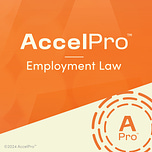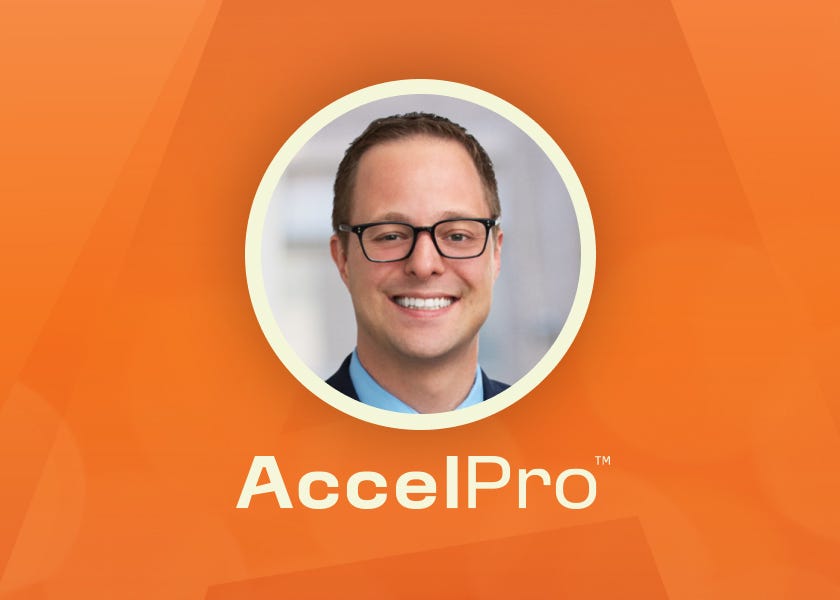You’re invited: AccelPro offers coaching sessions to help navigate your career.
On Working Effectively with Legal Recruiters featured a live discussion with a group of peers and a top recruiter in the field. Stay tuned for upcoming events.
Welcome to AccelPro Employment Law, where we provide expert interviews and coaching to accelerate your professional development. Today we’re featuring a conversation about best practices for employers hoping to avoid unionization. Our guest is David Pryzbylski, a partner at Barnes and Thornburg and thought leader on labor relations issues.
He says the key for employers hoping to avoid unionization is to forge a workplace with wages, benefits and policies strong enough that employees see no reason to organize.
The workplace landscape has changed, both socially and politically, since the pandemic. The NLRB has adopted more pro-labor positions, and employees have re-evaluated what they want and expect out of their employers. “People appear to be much more interested and open to the idea of unionization post-pandemic than they were pre-pandemic,” he says. “And that’s because of concerns about working conditions.”
AccelPro’s expert interviews and coaching accelerate your professional development. Join AccelPro Employment Law now for a free trial of everything we offer to members.
Interview References:
David Pryzbylski’s Barnes and Thornburg profile.
16:24 | Pryzbylski, David. Up and Away: Union Organizing Skyrockets 57% in Last Six Months. (2022, April 19). Barnes and Thornburg.
16:44 | Abruzzo, Jennifer. (2022, April 7). MEMORANDUM GC 22-04: The Right to Refrain from Captive Audience and other Mandatory Meetings. National Labor Relations Board General Counsel.
Supplemental Materials:
Unfair Labor Practices Charge Filings Up 16%, Union Petitions Remain Up in Fiscal Year 2023. (2023, April 7). National Labor Relations Board.
TRANSCRIPT
I. THE RISE IN INTEREST IN UNIONS
Matt Crossman, Host: We’re going to talk about steps companies can take to remain union free. But before we get to that, I’d like to lay some groundwork. In the culture, in the news and in actual fact, interest in unions seems sky high. In fiscal year 2022, 2,510 union petitions were filed—a 53 percent increase over 2021. At the same time, the NLRB has adopted more pro-labor positions. What do HR execs and employment attorneys need to know about how the increase in interest and changes at the NLRB are related, if they are?
David Pryzbylski: Let me start with how they’re related. I’ll start with the legal landscape first. As you noted, we’ve seen a lot of legal developments from the National Labor Relations Board since President Biden has had an opportunity to appoint what’s widely viewed as pro-union people to lead the NLRB.
So what we’ve seen is the board take incremental steps to make it legally easier for unions to file election petitions to represent workforces, and then to prevail in those union elections.
As they’ve paved the way to make it easier, we’ve simultaneously seen an increase in union activity. I think some of that’s related to the legal foundation that’s been laid to ease the way for them to make inroads into various companies, but I also think it’s kind of the luck of timing from a union perspective.
On the heels of the pandemic, we saw broad shifts in attitudes toward unions, and Starbucks is the primary example. In the last two years approximately, Starbucks has seen over 1,000 election petitions, so that accounts for much, not all, of that increase in union petition activity you just referenced.
It’s kind of a microcosm of what we’re seeing more broadly. And what I mean by that is people appear to be much more interested and open to the idea of unionization post-pandemic than they were pre-pandemic. And that’s because of concerns about working conditions. People saw workplaces in a different light and operating in a different way in the pandemic.
And then coming out of the pandemic, things started changing again, and that gave unions an opportunity to say, hey, if you don’t like some of these changes, guess what? We’re a third party voice that might be able to help you have more say in that process. At least that’s the sales pitch they give to employees when they’re trying to convince them to organize.
—
II. THE LOW-HANGING FRUIT OF BENEFITS AND WAGES
MC: You’re both a practitioner and a thought leader in this space, and you’ve identified several steps companies can take to remain union free. Everybody’s going to bring up pay and benefits. How can a company structure its pay and benefits so that when an employee looks elsewhere or thinks about a union, they will say, Nope, I’m actually doing pretty good.
DP: That’s a great question. Pay and benefits are always what I call low-hanging fruit, a threshold issue. If you’re not competitive on wages and benefits, it can be a catalyst to union organizing.
By and large union organizing drives tend to pop up when people feel disrespected at work. People are playing favorites among the supervisors. Policies are not being enforced consistently, et cetera.
But back to your point. Wages and benefits is something I think that if we can get competitive, make it transparent and quote unquote perceived as fair across the board, that’s going to take a strong piece of ammo away from the union and at minimum make our people feel valued, which is something A, we should want to do, and B, going to help us remain union free.
So when we’re looking at wages and benefits, I think it’s important for companies to do a few things. One on the wages side: Look at area and industry survey data to make sure you’re at or around market. Internally, make sure you’re paying people who are doing the same jobs the same way and at the same rate.
One of the worst things that can happen is all of a sudden somebody finds out they’re doing the exact same job, working the same hours, maybe even more, and they’re for some reason getting paid less and they don’t have an understanding as to why. That could certainly give rise to frustration and open the door for somebody like a union to come in and say, Hey, if you had us there, we wouldn’t let that happen to you.
Whether or not that’s true, that’s what they’re going to tell the employee. On the benefits side, I would tell you again, anecdotally in the last couple of years, non wage-based benefits, non health-care-based benefits, such as pet insurance, parental leave, all these other types of things that companies are doing, and employees are talking about, take an even higher position in employee’s minds as they’re considering what the total compensation package is.
So I think companies not only need to look at the traditional things like wages and health insurance, they also need to look at what are my competitors doing both in my industry and in my area for employees? Are they offering enhanced vacation and paid time off? Are they offering extended time away from work to work?
Those are the types of things that I think companies need to start looking at more and more. Because more and more employees are wanting those things, and unions oftentimes will say, Hey, if you vote us in, we’re going to push for those things, and we’re going to get them.
Again, that’s not always true, but that’s what they tell employees they’re going to do for them.
—
III. THE VALUE OF A UNION VULNERABILITY ASSESSMENT
MC: You also suggest companies run what’s called a union vulnerability assessment. What is that, when should a company do one and what will it show them?
Listen to this episode with a 7-day free trial
Subscribe to AccelPro | Employment & Labor Law to listen to this post and get 7 days of free access to the full post archives.












